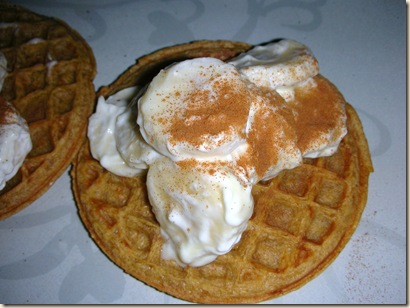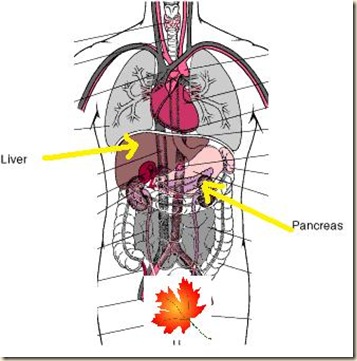Good morning! I am SO happy it’s Thursday. I kind of live for the weekends! 🙂 Plus, tonight I’m having dinner with Jenna and Meghann, which is always a good time with good eats.
Update on the leg/running situation: Many of you have asked me what exactly is wrong with my leg. Well–I’m not sure. My right calf is killing me. When I put my foot down, my heel throbs. However, I do feel a little better this morning, so hopefully it is just a tiny pulled muscle and I’ll be able to do the upcoming 15k and Half Marathon! I MAY try to run a short distance after work. MAYBE. We’ll see!
Onto happier news…..
Breakfast was divine AND quick–a perfect combination! I decided Fage and Banana Clouds are the perfect name for these waffles, as they are light and fluffy!
I mixed up 1/4 cup full fat Fage, 1/2 tablespoon maple syrup, and 1 large sliced banana. Then, I scooped the mixture onto two Kashi Heart to Heart waffles and sprinkled with cinnamon. Viola!
Who knew clouds could taste so good!?
Musings on the Great Lactic Acid Debate
Let me start off this "Musings" by stating I’m not a scientist–I’m just a layperson interested in health and fitness. I was taught runners should be scared of lactic acid, and I wondered if I really should be.
Here’s the summary of my research, which helped me understand the best way to train in order to maximize muscle efficiency. Feel free to post other insights or opinions!
Food = Fuel
After a meal containing carbohydrates is eaten and digested, blood sugar (aka blood glucose) levels rise, and the prances secretes insulin. This is why pre-run snacks are so important! The insulin acts on the liver to stimulate the action of several enzymes, including glycogen.
Here’s a diagram, because I didn’t know where the heck these things are even located. 🙂
Glycogen –> Muscles –> Lactic Acid
In order to contract, your muscles power themselves by “eating up” glycogen. The muscle glycogen is utilized through a process known as glycolysis. A by-product of glycolysis is lactic acid. The harder your exercise, the more lactic acid is produced. In turn, lactic acid levels get higher when you exercise strenuously.
The Old School Lactic Acid Theory
For a long time, runners feared lactic acid. When lactic acid was first identified by a biologist over 100 years ago, it was assumed that lack of oxygen to muscles led to the build-up of lactic acid, which caused muscles to fatigue. Lactic acid build-up was stigmatized as something to avoid.
This article summarizes how the earlier scientific belief that lactic acid was bad (which is what we probably all learned in school) affected the way runners trained. Athletes were told that they should spend most of their effort exercising aerobically, at a moderate intensity and moderate pace (like comfortably running). Athletes were also told that if they tried to spend too much time exercising in the anaerobic zone (like weight lifting or intense, long-term cardio), lactic acid would accumulate in the muscles, forcing them to stop.
The 21st Century Theory
Recent research suggest, however, that lactic acid has suffered from a terrible misclassification. It is not something terrible—in fact, glycolysis produces lactic acid, which is then used as FUEL for our body. It’s like: our bodies = a car and lactic acid = a magic, self-filling gas tank.
FYI, muscle fatigue is caused by a whole host of muscular and chemical reactions that are way too complex for this one post!
Ironically, it turns out that even though we thought lactic acid was bad, our technique for training is still the most beneficial for gaining strength in your muscles. That’s because aerobic exercise (moderate intensity, moderate pace) actually doubles the mitochondrial mass. This permits a more efficient uptake up lactic acid. Amazing!
Lactic Acidosis
Side note: Very high levels of lactic acid cause a serious, sometimes life-threatening condition called lactic acidosis. Symptoms of lactic acidosis include excessive sweating, rapid breathing, cool and clammy skin, sweet-smelling breath, belly pain, nausea or vomiting, and even coma. It is extremely rare and usually brought on by a combination of factors (i.e. extreme exercise + preexisting problems with your liver + interactions with medications).




